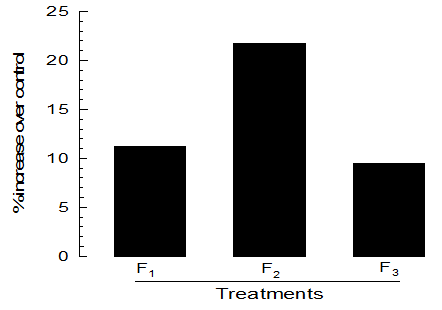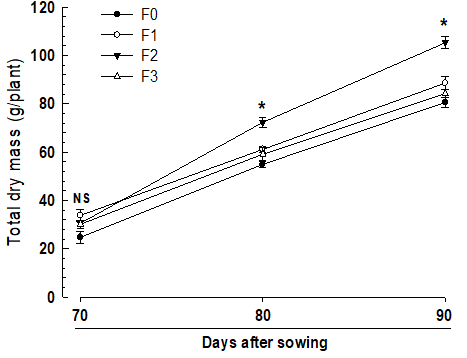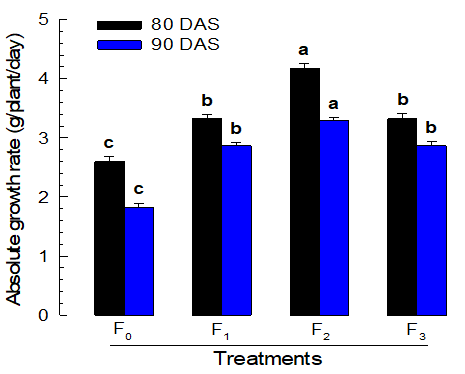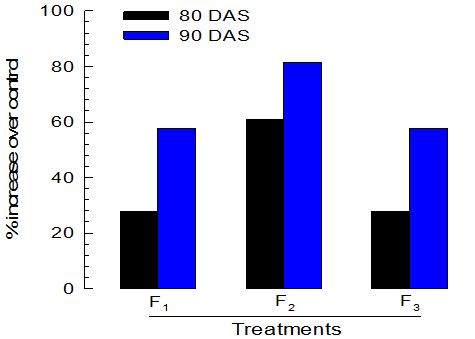
Applied Science Letters


The study was conducted at the BINA substation, Barisal to evaluate the effect of soil fertility status on chlorophyll content, growth, and yield of soybean. Binasoybean-3 was used for this study. The study was laid out in a randomized complete block design (RCBD) with three replications. Four soil fertility conditions such as F0 = no fertilizer, F1 = Rhizobium inoculation, F2 = NPK fertilizer, and F3 = Organic matter (Cow dung 2 tons ha-1). Macronutrient nitrogen (N), phosphorus (P), and potassium (K) were supplied as urea, triple super phosphate, and muriate of potash. The lowest chlorophyll content was measured in control plants while the highest was from NPK-treated plants which was 21.78% more compared to control. This increased chlorophyll content in NPK-treated plants results in the highest total dry mass (TDM) accumulation at both 80 and 90 days after sowing (DAS) compared to other treatments. The absolute growth rate was maximum in NPK-treated plants measured at both 80 DAS and 90 DAS providing a 60.83 and 81.49% increase compared to control, respectively. Yield contributing traits such as no. of branches per plant, no. of pods per plant, no. of grain per pod, and 1000 grain weight found maximum in NPK treated plants. Finally, grain yield was maximum in NPK-treated plants which was a 97.46% increase compared to control. Results revealed that sufficient application of NPK is required for maximum grain yield in soybeans. Sufficient NPK increased the chlorophyll in plants which eventually increased the plant growth and yield as well.
INTRODUCTION
Soybean is a rich source of phytochemicals and nutrients that contain a high number of free radicals and numerous phenolic compounds [1-3]. The phenolic content is highly associated with antioxidant activity [4, 5]. Consumption of soybean seed has been associated with several health-enhancing properties such as lowering the rates of colon, prostate, and breast cancers [6]; reducing blood cholesterol levels and the risk of cardiovascular disease [7]; prevention of osteoporosis and reduction of post-menopausal symptoms [8]. Soybean also contains many essential amino acids that are lacking in most cereal, grain-based diets fed to swine and poultry [9]. Due to several health benefits for humans, poultry, and livestock, soybean has extreme market potential in the food processing industry and animal feed. It has been utilized to fortify fritters for the improvement of the nutritional status of rural communities [10, 11]. Thus, soybean has great importance and demand throughout the world including Bangladesh.
In Bangladesh, soybean cultivation is dominated in Bhola and Noakhali districts. Farmers are less interested in cultivating and consuming soybeans due to a lack of knowledge about the health benefits, limited access to improved varieties and cultivation practices including fertilizer management especially the use of phosphate and inoculum fertilizers needed for boosting chlorophyll content, grain growth, and yields of soybean [12]. The chlorophyll content is an important index to measure crop growth that increases the photosynthetic capacity of leaves [13]. Rhizobium strains enhance nitrogen (N) fixation in soybean which increases soybean yield [14-16]. The chemical fertilizer, especially phosphorus (P) plays a crucial role in seed formation and yield [17]. Chemical fertilizer such as N, P, and K also helps the uptake of nutrients, influence the growth of roots, and nodule formation, balance the N deficiency in the soil, and aid in seed maturation [18]. Previous studies reported that integrated soil fertility management (ISFM) practices like co-application of organic manure and P fertilizers are very useful for the improvement of the plant health and yield of soybean grain [19-22]. However, there was a lack of information about its effect on increasing chlorophyll content, plant growth, and seed yield. This study aims to investigate the effect of soil fertility conditions on chlorophyll content, plant growth, and grain yield in soybeans.
MATERIALS AND METHODS
A field study was conducted during the Rabi season in 2022 at the BINA sub-station Barisal, Bangladesh. This area lies between 22.8162 °N latitude and 90.3137 °E longitude and 2 meters altitude from sea level. The climate is characterized by alternate hot and cold seasons. The study was laid out in randomized complete block design (RCBD) with three replications. Four treatments F0 = No fertilizer, F1 = Rhizobium inoculum, F2 = NPK fertilizer, and F3 = Cow dung (2 tons ha-1) were applied in the Binasoybean-3 crop field. Seeds were sown on 5th January 2022 in unit plot size (3 m × 2.5 m) maintaining 30cm apart in rows. For the treatment of F1, soybean seeds were treated with Rhizobium biofertilizer before sowing, for F2 each plot was fertilized with urea @ 86.95 kg/ha, TSP @ 66.67 kg/ha and MoP @ 100 kg/ha and for the treatment of F3 each plot was fertilized with organic matter (Cow dung) @ 2000 kg/hectare.
Chlorophyll meter SPAD - 502 (Minolta, Japan) was used for measuring the nitrogen in the leaves following [23]. The method includes the direct measurement of chlorophyll a+b in the leaves. This device works on measuring the light transmission through the leaves in two wavelengths 650 and 940 nm and automatically calculates an average of these two data and indicates the so-called SPAD number. After 70 days of sowing, at every 10-day interval, 5 plants were harvested and oven-dried at 70 ± 2 ⁰C for the determination of growth rate and total dry matter. The rate of absolute growth was calculated as the total increase in plant dry weight over a given period. The growth analysis was carried out following the formula described by Hunt [24] as:
|
|
(1) |
Here, W1 = Dry weight at the initial time
W2 = Dry weight at the final time
T1 = Initial time
T2 = Final time
After attaining physiological maturity, five plants were collected from each plot for recording yield contributing parameters, and one quadrate (1 m2) was harvested in every plot to determine the yield that converted to ton per hectare. Using the analysis of variance technique by SPSS software, all data were subjected to statistical analysis separately. Using Duncan's Multiple Range Test at 5% probability levels, the difference among treatment means was compared.
RESULTS AND DISCUSSION
Chlorophyll content in the leaf depends on the NPK level in the soil
Chlorophyll content in the leaf was measured using the Chlorophyll meter SPAD-502 (Minolta, Japan). The level of NPK in the soil significantly (P > 0.05) controls the chlorophyll content in the leaf of soybean. The highest chlorophyll content (47.53) was measured in NPK-treated soybean plants that were statistically different but followed by Rhizobium (43.42) and Organic matter (42.73) treated plants while the lowest of that was measured from control (39.03) (Figure 1a). The rate of increase of chlorophyll content compared to control was also measured and the maximum of that was obtained from NPK-treated plants (21.78%) which was followed by Rhizobium (11.25%) and organic matter-treated plants (9.48%) (Figure 1b). Thus, it can be summarized that an increased level of NPK increases the chlorophyll content in soybeans. Wamalwa et al. [25] and Pingale and Amrutkar [26] reported that increased application of NPK in finger millet increased the chlorophyll content in the leaf.
 |
|
a) |
 |
|
b) |
|
Figure 1. Effect of soil fertility condition for enhancing chlorophyll content in leaf (a) Chlorophyll content (SPAD Value), (b) Percent increase over control. Different letters above standard deviation denote significant differences among means at Type I error = 0.05 (LSD test). |
Effect of NPK application on total dry mass accumulation
Bina soybean-3 shows different growth rates in different soil fertility conditions and total dry mass (TDM) increased significantly (P > 0.05) with the increased age of the plant until maturity. At 70 DAS, maximum TDM accumulation was recorded in Rhizobium (33.87 g/plant) which was followed by NPK (30.59 g/plant) and organic matter (30.19 g/plant) treated plants while in control plants it was recorded as the lowest (24.80 g/plant) (Figure 2). For 80 DAS, it was maximum for NPK treated plants (72.39 g/plant) which were followed by Rhizobium (61.18 g/plant), organic matter (59.18 g/plant) treated plants, and a minimum of that from untreated control (55.02 g/plant) (Figure 2). A similar trend was observed for 90 DAS (Figure 2). After 70 DAS, NPK-treated soybeans produced the highest TDM at all growth stages and these were statistically different from other treatments. Mete et al. [27] reported that total biomass production in soybeans increased mostly for NPK application compared to organic matter.
 |
|
Figure 2. Changes in total dry mass (TDM) at different growth stages of soybean under Different soil fertility conditions. Asterisks represent significant differences among means at Type I error = 0.05 (LSD test). |
Effect of soil N, P, K level on absolute growth rate of soybean
The absolute growth rate (AGR) also increased significantly (P > 0.05) with the increased age of the plant until 80 DAS followed by a decline at 90 DAS in all treatments of soybean (Figure 3a). The AGR increased at 80 DAS in all treatments because plants were at the pod development stage. The AGR was greater in NPK-treated plants while lowest in untreated control plants. Both at 80 DAS and 90 DAS, the maximum absolute growth rate was observed in NPK-treated plants (4.18 and 3.29 g/plant/day) which was followed by Rhizobium (3.32 and 2.86 g/plant/day) and organic matter (3.32 and 2.86 g/plant/day) treated plants and lowest was in control (2.59 and 1.82 g/plant/day) plants. The extent of growth rate increase in treated plants compared to control can easily be understood from the percent increase of growth rate over control (Figure 3b). In NPK-treated plants, the percent increase of growth was higher (64 and 84% at 80 and 90 DAS, respectively) than in Rhizobium-treated plants (28 and 60% at 80 and 90 DAS, respectively) and Organic-treated plants (28 and 64% at 80 and 90 DAS, respectively). This result revealed that a higher content of chlorophyll confirmed higher dry mass accumulation and a higher absolute growth rate. Thompson et al. [28] and Haidar and Al-Shorafa [29] reported a strong correlation of Chlorophyll content with areal leaf mass (ALM) in soybeans.
 |
|
a) |
 |
|
b) |
|
Figure 3. Effect of different soil fertility conditions in the growth of soybean at different time points. (a) Changes in absolute growth rate (AGR) (b) Percent increase of growth rate over control. Different letters above standard deviation denote significant differences among means at Type I error = 0.05 (LSD test). |
Effect of nutritional status on morphological characters and yield attributes
Difference in soil fertility conditions, significantly (P < 0.05) affects the morphological and yield attributes (Table 1). Organic matter-treated soybean plants bore a maximum number of branches that were statistically like NPK while the lowest of that was found in Rhizobium-treated soybean plants which was statistically the same as untreated control. A maximum number of pods per plant was recorded in NPK-treated plants which were followed by organic matter-treated plants while the lowest of that was found in control and Rhizobium-treated plants. A maximum number of grains was collected from NPK-treated plants and it was statistically the same for Rhizobium and control plants. Seed size leading to 1000 grain weight was maximum in NPK treated plants which were statistically similar to organic matter treated plants while the lowest of that was recorded from Rhizobium which was statistically similar to control plants. The highest amount of grain yield was collected from NPK-treated plants (2.33-ton ha-1) as the number of pods per plant, number of grains per pod, and seed weight were maximum in these plants. In contrast, the lowest grain yield was recorded from control plants (1.18 tons ha-1). The maximum increase in grain yield over control was recorded from NPK-treated plants (97.46%) while it was 55.93% and 18.64% for organic matter and Rhizobium, respectively. This result concludes that maximum chlorophyll content confirmed maximum dry matter accumulation by increasing photosynthesis which enhances the absolute growth rate, branching, pod formation, grain weight, and finally increased grain yield. These results were following Dzhidzalov et al. [30] and Shi et al. [31] who described a direct correlation between photosynthesis and dry matter accumulation in soybean. Another study by Mete et al. [27] and AlGarni et al. [32] reported that the application of NPK increased soybean yield more than the organic matter application.
Table 1. Yield and yield contributing characters at different soil fertility conditions.
|
Treat- ments |
Branch plant-1 |
Pods plant-1 |
Grain Pod-1 |
1000 grain weight |
Grain yield (ton ha1) |
% yield increase |
|
F0 |
3.78 ± 0.19b |
60.45 ± 1.68c |
7.89 ± 0.70a |
10.17 ± 0.31b |
1.18 ± 0.09d |
0.00 |
|
F1 |
3.66 ± 0.18b |
60.40 ± 2.89c |
8.22 ± 0.51a |
10.07 ± 0.26b |
1.40 ± 0.11c |
18.64 |
|
F2 |
4.11 ± 0.32a |
72.22 ± 2.50a |
8.22 ± 0.42a |
11.51 ± 0.87a |
2.33 ± 0.19a |
97.46 |
|
F3 |
4.44 ± 0.31a |
66.22 ± 2.77b |
8.11 ± 0.51a |
10.83 ± 0.29a |
1.84 ± 0.05b |
55.93 |
This means having different letters are significantly different (Duncan's Multiple Range Test, p < 0.05)
This result also denotes that a higher growth rate at the vegetative and flowering stages is desirable for getting higher seed yield in soybeans. Crop’s early ability to intercept solar radiation and its subsequent utilization for biomass production represents its growth and yield [33]. In soybeans, increased interception of solar radiation at early seedling stages enables the plant to make rapid early growth, which results in higher yield [11, 34]. In the current research, a similar phenomenon occurred in NPK-treated soybean giving higher production of absolute growth rate (AGR) and total dry mass (TDM) at the early growth stage, which results in maximum seed yield.
CONCLUSION
The present study reports that NPK-treated soybean confirmed maximum chlorophyll content that produces absolute growth rate (AGR) and maximum total dry mass (TDM) at the early growth stage and flowering stage, resulting in a maximum number of branches, number of pods per plant, and seed weight that finally contributes maximum seed yield. Therefore, it can be concluded that enhanced chlorophyll content increases absolute growth rate and is positively correlated with increasing seed yield.
ACKNOWLEDGMENTS: We would like to express the heartiest respect, gratitude, and profound appreciation to the Director of Research and CSO RC, Bangladesh Institute of Nuclear Agriculture, Mymensingh who allowed me to conduct this research. I would like to thank Md. Sohel Rana for providing Rhizobium Inoculum. Also thank other colleagues of BINA substation Barisal for their assistance in conducting this study.
CONFLICT OF INTEREST: None
FINANCIAL SUPPORT: None
ETHICS STATEMENT: None
